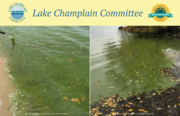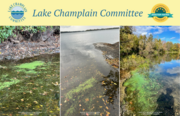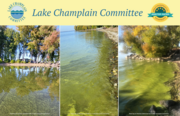In this email you’ll find details of Week 18 monitoring along with information to help you recognize and report on cyanobacteria. Click on the links for scenes of fall blooms on Lake Champlain’s Inland Sea and Missisquoi Bay; a low alert bloom at Burlington’s Coast Guard boat access on Lake Champlain’s Main Lake Central; pictures of the varied conditions witnessed during Week 18 from clear water to high alert blooms; photos of Prouty Bay Lake Memphremagog post-bloom; shots of a high alert at Philipsburg Public Park QC on Lake Champlain’s Missisquoi Bay; pristine scenes at Blanchard Beach and Texaco Beach in Burlington VT on Lake Champlain’s Main Lake Central; autumn observations at St. Anne’s Shrine in Isle La Motte VT, and Burlington VT sites at Blanchard Beach, Oakledge Rocky Shore, and North Beach; and a snapshot of Missisquoi Bay monitor Nancy Lambert in action at her QC site. Read...
News from Selected Month
Brrr! It’s getting chilly in and around our waterways as fall fully takes hold. However, cyanobacteria blooms are still happening at various Lake Champlain and inland lake locations. Please use the resources in this email to learn how to recognize, avoid, and report cyanobacteria. Read on for details of Week 17 monitoring results along with resources to guide your reporting. Click on the links for a picture of LCC monitor Alfred Cumming taking a cold water sample, scenes of low alert blooms at Lake Memphremagog’s Derby Bay and Newport Marina and at Lake Champlain sites on Missisquoi Bay and the Inland Sea, and pictures of Lake Champlain clear water at St. Anne’s Shrine, Stoney Point, and DAR State Park.
While reports continue to dwindle as more monitors leave shoreline areas, we continue to see blooms. Please use the resources in this email to learn how to recognize, avoid, and report cyanobacteria. Click on the links for how to join our monitoring team in 2024 and to see pictures clear water conditions at Philipsburg QC and Burlington VT, an autumn alert at Hills Point Charlotte VT, fall leaves amongst cyanobacteria, and blooms at Graveyard Point North Hero VT on Lake Champlain and Prouty Bay on Lake Memphremagog. Read...
Fall is a time of year when we have far fewer monitors reporting but blooms can still occur. This email includes details of Week 15 monitoring results along with resources to help you recognize cyanobacteria and stay informed about water quality. You’ll also find photos of iron bacteria, bloom close-ups from Lake Champlain and Lake Memphremagog, and cyanobacteria sightings at Philipsburg QC, Isle La Motte VT, Alburgh VT, North Hero VT, South Burlington VT, Peacham Pond, and Lake Memphremagog. Read...




